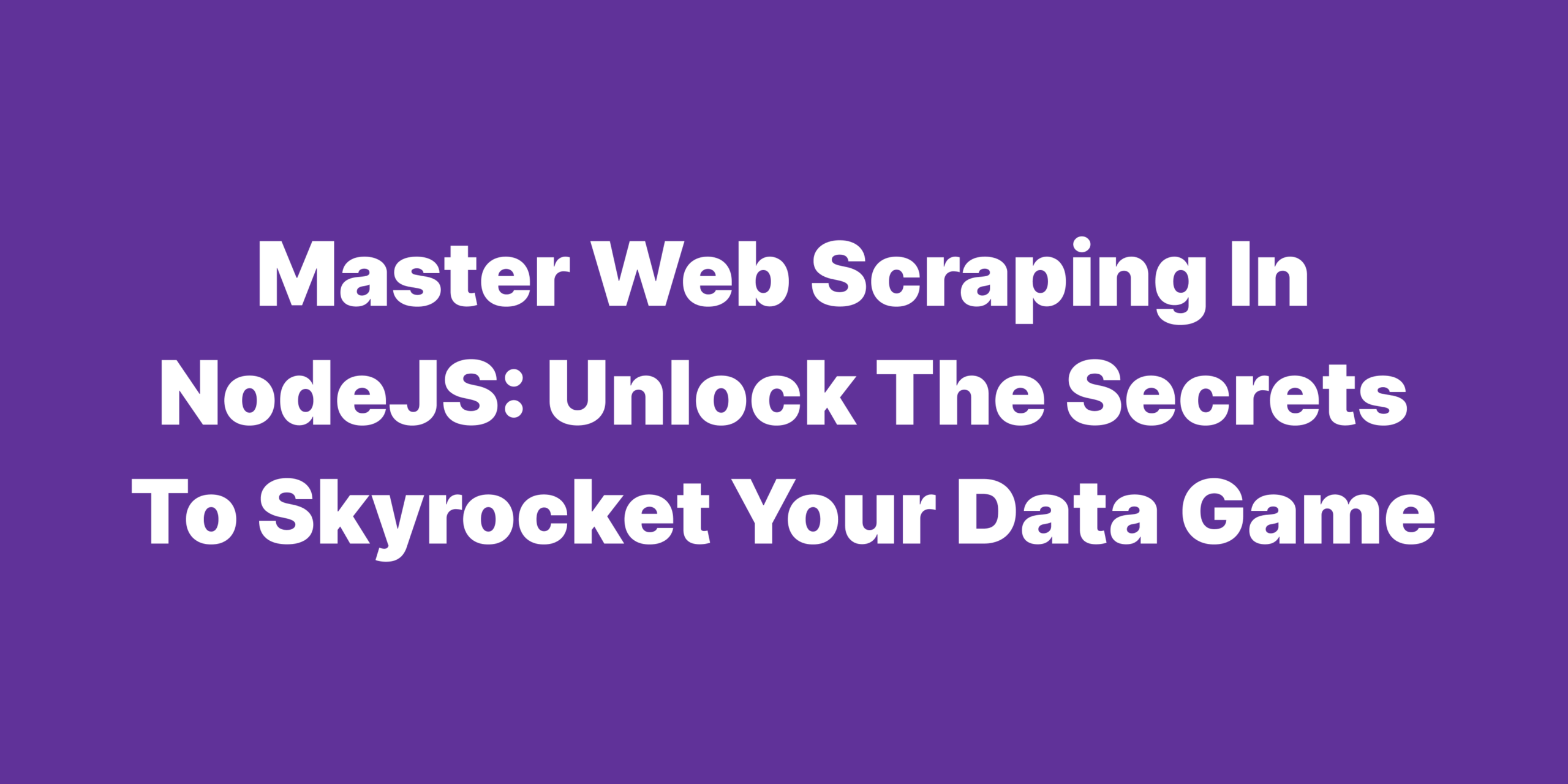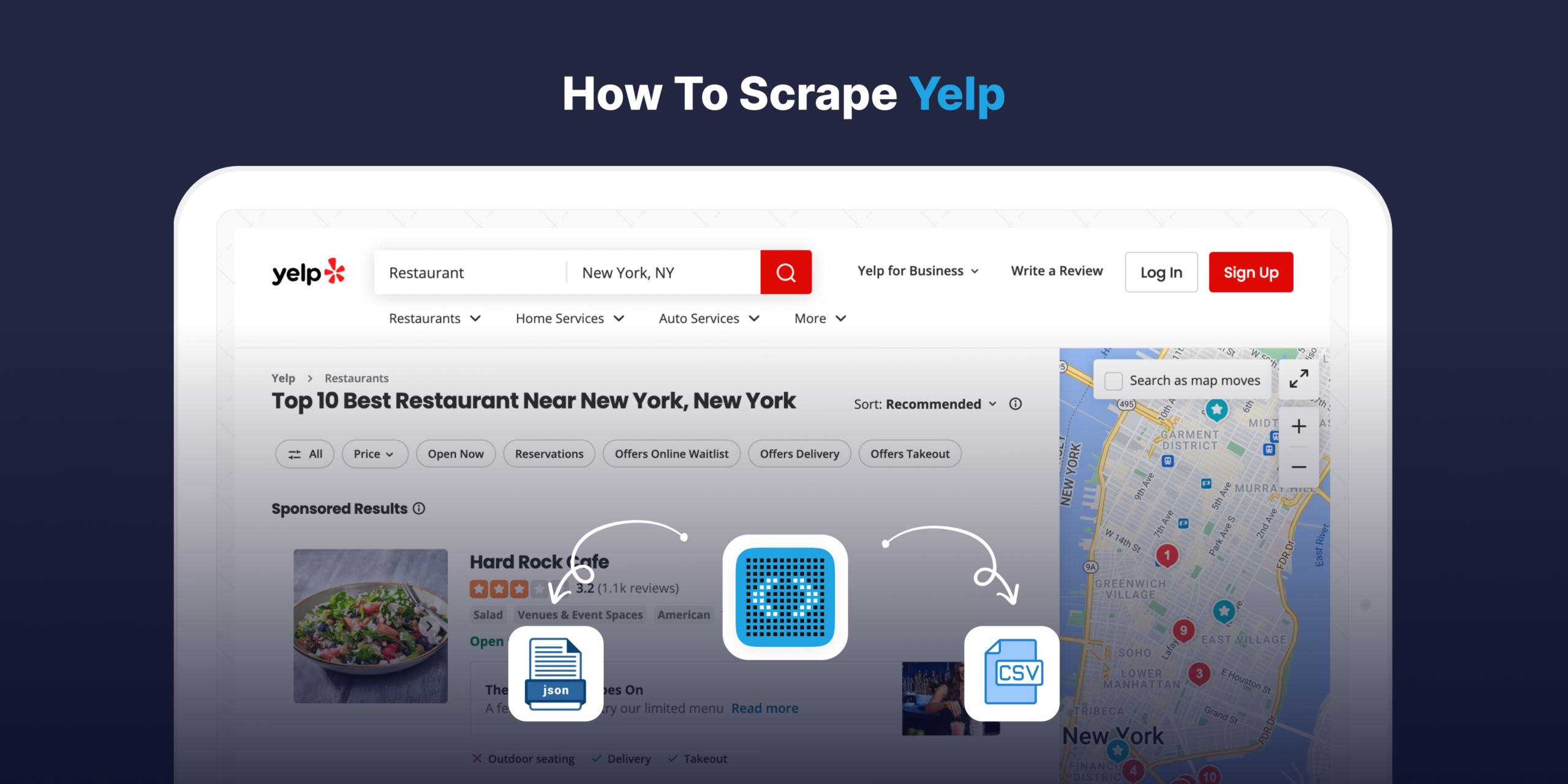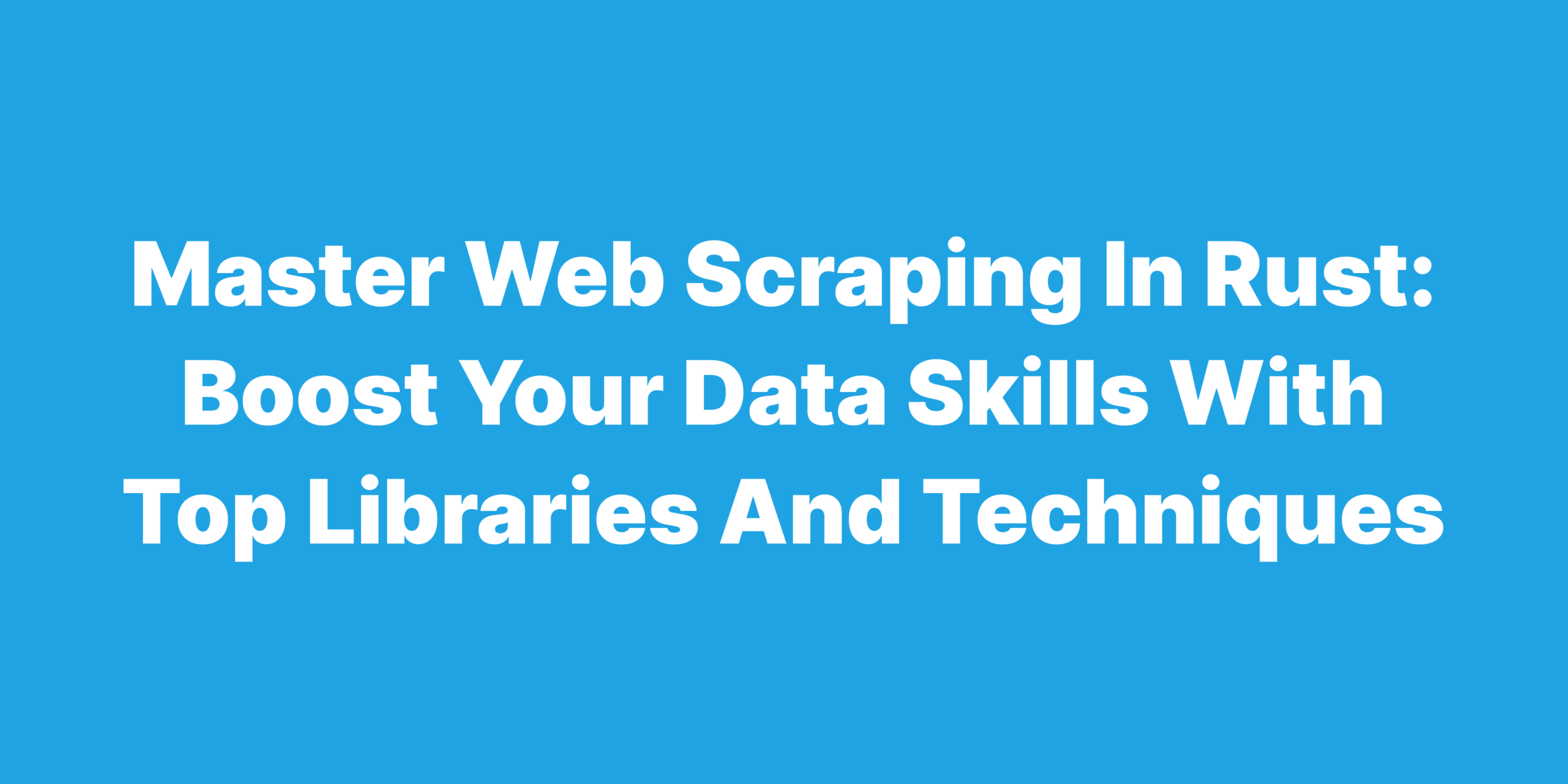The world of data extraction is rapidly evolving, and NodeJS has proven to be an incredibly versatile language for web scraping. Thanks to its non-blocking, event-driven architecture, NodeJS can handle numerous requests simultaneously, making it a popular choice for developers looking to extract large volumes of data from websites quickly and efficiently. For developers and researchers seeking a reliable and powerful tool to facilitate their web scraping projects, scraping API presents a perfect solution, boasting a wide range of features designed to optimize the data extraction process. Its robust ecosystem of libraries and packages, such as Cheerio and Puppeteer, enables developers to write powerful web scraping scripts with ease, simplifying the process of targeting, extracting, and parsing data from websites.
Before diving into web scraping with NodeJS, it’s crucial to set up a proper development environment. First, ensure that you have the latest version of NodeJS installed on your computer. You can download it from the official NodeJS website or use a package manager like NPM (Node Package Manager) to manage your installations. Once NodeJS is installed, create a new directory for your web scraping project and initialize it with NPM by running npm init in your terminal. This command will generate a package.json file, which will keep track of your project’s dependencies and metadata.
Understanding basic web scraping concepts is essential to harnessing the full potential of NodeJS in your data extraction projects. At the core of web scraping lies the idea of targeting specific HTML elements within a web page to extract the data you need. Familiarize yourself with the structure of HTML documents, including elements like tags, attributes, and classes, as this knowledge will prove invaluable when writing your web scraping scripts. Also, learn how to send HTTP requests to fetch web pages and parse their content using NodeJS libraries. By mastering these fundamentals, you’ll be well-equipped to tackle any web scraping challenge with confidence.
Unleashing Web Scraping Potential with NodeJS
Embracing NodeJS as a web scraping language opens up a world of possibilities for extracting valuable data from the web. As an asynchronous, event-driven, and scalable language, NodeJS excels in handling numerous requests simultaneously, making it an ideal choice for developers looking to fetch data from multiple sources quickly and efficiently. To get started with web scraping in NodeJS, it’s essential to set up the proper development environment. This involves installing the latest version of NodeJS, initializing a new project with a package manager like NPM, and understanding how to send HTTP requests and parse HTML content using various NodeJS libraries. By mastering these basic web scraping concepts, you’ll be well-equipped to tackle any data extraction challenge and turn unstructured web data into actionable insights.
The Art of Identifying HTML Objects by ID in NodeJS
HTML objects are the building blocks of web pages, consisting of elements such as headings, images, links, and text. They are crucial for web scraping because they hold the data that you want to extract. By identifying specific HTML objects, you can pinpoint the exact information you’re looking to collect and avoid sifting through irrelevant content. In web scraping projects, it’s common to use unique identifiers, such as the “ID” attribute of an HTML element, to locate specific objects on a page.
To identify HTML objects by ID in NodeJS, you can use various libraries like Cheerio or Puppeteer. These libraries provide methods to navigate and manipulate HTML content, making it easier to target objects by their ID attributes. For instance, with Cheerio, you can employ a jQuery-like syntax to select elements by ID, while Puppeteer allows you to interact with the elements in a headless browser environment. Both approaches offer a convenient way to identify HTML objects by ID and extract the desired data.
Let’s consider an example of identifying HTML objects by ID in NodeJS. Suppose you want to extract the title and description of a blog post from a web page. Using Cheerio, you can load the HTML content into a variable and then select the elements with the corresponding ID attributes using the $('#elementID') syntax. Similarly, with Puppeteer, you can launch a headless browser, navigate to the web page, and use methods like page.$('#elementID') to locate the elements by their ID. Once you’ve identified the desired HTML objects, you can extract their content and proceed with further data analysis or processing.
Comparison of the 5 Best Libraries for Web Scraping in NodeJS
Cheerio
Pros
- Easy to learn and use, especially for those familiar with jQuery.
- High performance and speed.
- Small footprint, making it ideal for resource-constrained environments.
Cons
- Limited to static websites; cannot interact with JavaScript-rendered content.
- Lacks built-in support for handling HTTP requests.
- No built-in support for dealing with captchas or handling login forms.
Puppeteer
Pros
- Can interact with JavaScript-rendered content and dynamic websites.
- Supports advanced web automation tasks, such as form submissions and handling cookies.
- Maintained by the Chrome team, ensuring ongoing compatibility with the latest browser features.
Cons
- Higher resource consumption compared to lightweight alternatives.
- Steeper learning curve for those new to browser automation.
- Can be slower than other libraries due to the overhead of controlling a full browser instance.
Axios
Pros
- Simple and intuitive API for handling HTTP requests and responses.
- Supports a wide range of HTTP methods and configurations.
- Works in both browser and NodeJS environments.
Cons
- Requires additional libraries for parsing and manipulating HTML content.
- Lacks advanced web scraping features such as handling JavaScript-rendered content.
- Not optimized for web scraping performance.
jsdom
Pros
- Provides a complete DOM implementation, allowing for complex HTML manipulations.
- Runs in NodeJS, enabling server-side DOM manipulation and scraping tasks.
- Can be combined with other libraries for a comprehensive web scraping solution.
Cons
- Relatively slower than lightweight alternatives like Cheerio.
- Requires a separate HTTP request library for fetching web pages.
- Can be more complex to work with compared to jQuery-like syntax.
Apify
Pros
- Highly scalable, capable of handling large-scale web scraping projects.
- Offers built-in support for handling proxies, retries, and caching.
- Provides a set of utilities for common web scraping tasks such as URL parsing and data storage.
Cons
- More complex to set up and configure compared to lightweight alternatives.
- May be overkill for small-scale or simple web scraping tasks.
- Steeper learning curve for those new to web scraping and crawling.
By weighing the pros and cons of each library, you can make an informed decision on the best library to use for your web scraping project in R. Whether you prioritize ease-of-use, powerful capabilities, or speed, there is a library suited for your specific requirements.
Crafting a Web Scraper to Extract Page HTML in NodeJS
Examples of building a web scraper in R
Building a web scraper in NodeJS involves creating a script or application that fetches and processes the HTML content of a web page. The process requires leveraging NodeJS libraries to send HTTP requests, navigate the HTML structure, and extract the desired data. When designed well, a web scraper can efficiently collect valuable information from websites and transform it into a structured format for further analysis or use.
To build a web scraper in NodeJS, follow these steps:
- Set up your NodeJS development environment, including installing the required libraries for web scraping (e.g., Cheerio, Puppeteer, Axios, or Request-Promise).
- Write a function to send an HTTP request to the target URL and fetch the HTML content of the page.
- Use a NodeJS library to parse the fetched HTML content, enabling you to navigate and manipulate the page structure.
- Identify the HTML objects containing the data you want to extract, using techniques like locating elements by ID, class, or tag.
- Extract the desired data from the HTML objects and store it in a structured format, such as a JSON object or CSV file.
- Implement error handling and logging to ensure the web scraper can handle unexpected issues and provide feedback on its progress.
- Optimize the web scraper for performance, such as by implementing concurrency, caching, or pagination handling.
For example, let’s say you want to build a web scraper in NodeJS to collect product information from an e-commerce website. First, you would install the necessary libraries (e.g., Axios and Cheerio) and create a script to fetch the HTML content of the product page. Next, you would use Cheerio to parse the HTML and identify the elements containing the product name, price, and description. Once you have located these elements, you can extract the data and store it in a structured format for further analysis or use. By following these steps, you can create a powerful web scraper capable of gathering essential data from websites and transforming it into actionable insights.
Mastering HTML Parsing with NodeJS Libraries
Parsing HTML with NodeJS Libraries: Real-World Examples
Example 1: Extracting headlines from a news website using Cheerio
Suppose you want to extract the headlines from the front page of a news website like “https://example-news-site.com“. Using Axios and Cheerio, you can achieve this as follows:
javascriptCopy codeconst axios = require('axios');
const cheerio = require('cheerio');
axios.get('https://example-news-site.com')
.then(response => {
const html = response.data;
const $ = cheerio.load(html);
const headlines = [];
$('h2.headline').each((index, element) => {
headlines.push($(element).text());
});
console.log(headlines);
})
.catch(error => {
console.error(`Error: ${error}`);
});
In this example, we fetch the HTML content of the news website using Axios and load it into Cheerio. We then select all h2 elements with the class headline and extract the text inside them, storing the headlines in an array.
Example 2: Scraping product details from an e-commerce site using Puppeteer
Imagine you want to scrape product details (name, price, and image URL) from an e-commerce website like “https://example-ecommerce-site.com“. The site uses JavaScript to load content, so we’ll use Puppeteer to handle the dynamic nature of the site:
javascriptCopy codeconst puppeteer = require('puppeteer');
(async () => {
const browser = await puppeteer.launch();
const page = await browser.newPage();
await page.goto('https://example-ecommerce-site.com/products');
const products = await page.evaluate(() => {
const productElements = document.querySelectorAll('.product');
const productData = [];
productElements.forEach(element => {
const name = element.querySelector('.product-name').innerText;
const price = parseFloat(element.querySelector('.product-price').innerText.replace('$', ''));
const imageURL = element.querySelector('.product-image').src;
productData.push({ name, price, imageURL });
});
return productData;
});
console.log(products);
await browser.close();
})();
In this example, we launch a headless browser using Puppeteer and navigate to the e-commerce site’s products page. After the page loads, we evaluate JavaScript on the page to select all elements with the class product and extract the product name, price, and image URL. The extracted data is then stored in an array of objects.
These examples demonstrate how NodeJS libraries, like Cheerio and Puppeteer, can be used to parse HTML content and extract valuable data from websites.
Conclusion
To sum up, web scraping with NodeJS is a powerful technique that empowers data enthusiasts to gather and analyze information from websites. By understanding how to identify HTML objects, select the most appropriate NodeJS libraries, and build efficient web scrapers, you can transform unstructured web content into structured data for further analysis. As we continue to embrace the digital age, web scraping will play an increasingly vital role in data analysis, helping us uncover insights and drive informed decision-making. Stay curious, and keep exploring the vast potential of web scraping in NodeJS to stay ahead in the ever-evolving world of data.
Frequently Asked Questions
Why is it essential to identify HTML objects by ID when performing web scraping?
Identifying HTML objects by ID is essential in web scraping for accurate and efficient data extraction. Unique IDs allow precise targeting of specific elements, ensuring only relevant data is collected while reducing errors and improving scraper efficiency. By using IDs instead of classes or attributes, web scrapers can precisely locate and extract desired information, enhancing the accuracy and effectiveness of web scraping endeavors.
How do I create a web scraper in NodeJS for extracting page HTML?
Creating a web scraper in NodeJS for extracting page HTML involves choosing an appropriate library, such as Cheerio or Puppeteer, based on the complexity of the target website. Once the library is selected, you’ll need to fetch the web page’s content, typically using a package like Axios or the built-in functionality of Puppeteer. After obtaining the HTML content, you can employ the chosen library’s features to parse the HTML and extract the desired data. With the right combination of libraries and techniques, you’ll be able to build a powerful and efficient web scraper in NodeJS.
What are the key differences between Axios and Chrurios for parsing HTML code in NodeJS?
Axios and Cheerio serve different purposes in NodeJS web scraping. Axios is a promise-based HTTP client for fetching web pages, while Cheerio is designed for parsing and manipulating HTML with a jQuery-like syntax. To build a web scraper, you would typically use Axios to retrieve the page and Cheerio to extract the desired data from the fetched HTML.
How can I stay updated on the latest developments in web scraping libraries and best practices?
Stay ahead in web scraping by following top blogs, forums, and newsletters. Engage with developers and users on platforms like GitHub and Stack Overflow, and join community discussions. For crucial insights, subscribe to the Scrape Network blog now!






